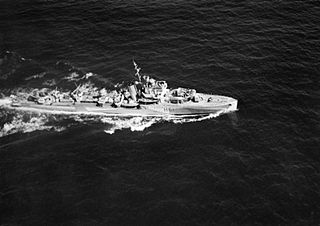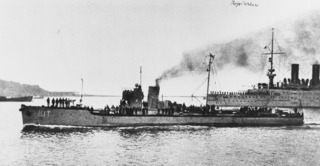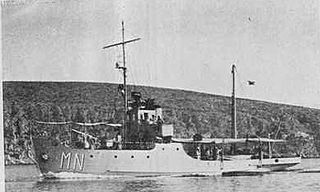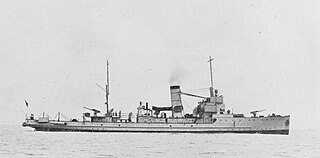
HMS Express was an E-class minelaying destroyer built for the Royal Navy in the early 1930s. Although assigned to the Home Fleet upon completion, the ship was attached to the Mediterranean Fleet in 1935–36 during the Abyssinia Crisis. During the Spanish Civil War of 1936–1939, she spent considerable time in Spanish waters, enforcing the arms blockade imposed by Britain and France on both sides of the conflict.

Vasilissa Olga was the second and last destroyer of her class built for the Royal Hellenic Navy in Great Britain before the Second World War. She participated in the Greco-Italian War in 1940–1941, escorting convoys and unsuccessfully attacking Italian shipping in the Adriatic Sea. After the German invasion of Greece in April 1941, the ship escorted convoys between Egypt and Greece until she evacuated part of the government to Crete later that month and then to Egypt in May. After the Greek surrender on 1 June, Vasilissa Olga served with British forces for the rest of her career.

Vasilefs Georgios was the lead ship of her class of two destroyers built for the Royal Hellenic Navy before the Second World War. Flagship of the navy's Destroyer Flotilla, she participated in the Greco-Italian War in 1940–1941, escorting convoys and unsuccessfully attacking Italian shipping in the Adriatic Sea. While under repair during the Axis invasion of Greece in 1941, Vasilefs Georgios sank when the floating drydock that she was in was either scuttled or sunk by German aircraft.

Dubrovnik was a flotilla leader built for the Royal Yugoslav Navy by Yarrow Shipbuilders in Glasgow in 1930 and 1931. She was one of the largest destroyers of her time. Resembling contemporary British designs, Dubrovnik was a fast ship with a main armament of four Czechoslovak-built Škoda 140 mm (5.5 in) guns in single mounts. She was intended to be the first of three flotilla leaders built for Yugoslavia, but was the only one completed. During her service with the Royal Yugoslav Navy, Dubrovnik undertook several peacetime cruises through the Mediterranean, the Turkish Straits and the Black Sea. In October 1934, she conveyed King Alexander to France for a state visit, and carried his body back to Yugoslavia following his assassination in Marseille.

T3 was a sea-going torpedo boat that was operated by the Royal Yugoslav Navy between 1921 and 1941. Originally 78 T, a 250t-class torpedo boat of the Austro-Hungarian Navy built in 1914, she was armed with two 66 mm (2.6 in) guns, four 450 mm (17.7 in) torpedo tubes, and could carry 10–12 naval mines. She saw active service during World War I, performing convoy, escort and minesweeping tasks, anti-submarine operations and shore bombardment missions. In 1917 the suffixes of all Austro-Hungarian torpedo boats were removed, and thereafter she was referred to as 78. She was part of the escort force for the Austro-Hungarian dreadnought Szent István during the action that resulted in the sinking of that ship by Italian torpedo boats in June 1918.

The Royal Navy, commonly the Royal Yugoslav Navy, was the naval warfare service branch of the Kingdom of Yugoslavia. It was brought into existence in 1921, and initially consisted of a few former Austro-Hungarian Navy vessels surrendered at the conclusion of World War I and transferred to the new nation state under the terms of the Treaty of Saint-Germain-en-Laye. The only modern sea-going warships transferred to the new state were twelve steam-powered torpedo boats, although it did receive four capable river monitors for use on the Danube and other large rivers. Significant new acquisitions began in 1926 with a former German light cruiser, followed by the commissioning of two motor torpedo boats (MTBs) and a small submarine flotilla over the next few years. When the name of the state was changed to Yugoslavia in 1929, the name of its navy was changed to reflect this. In the late 1920s, several of the original vessels were discarded.

SMS Niobe was the second member of the ten-ship Gazelle class of light cruisers that were built for the German Kaiserliche Marine in the late 1890s and early 1900s. The Gazelle class was the culmination of earlier unprotected cruiser and aviso designs, combining the best aspects of both types in what became the progenitor of all future light cruisers of the Imperial fleet. Built to be able to serve with the main German fleet and as a colonial cruiser, she was armed with a battery of ten 10.5 cm (4.1 in) guns and a top speed of 21.5 knots. The ship had a long career, serving in all three German navies, along with the Yugoslav and Italian fleets over the span of more than forty years.

T1 was a seagoing torpedo boat that was operated by the Royal Yugoslav Navy between 1921 and 1941. Originally 76 T, a 250t-class torpedo boat of the Austro-Hungarian Navy built in 1914, she was armed with two 66 mm (2.6 in) guns and four 450 mm (17.7 in) torpedo tubes, and could carry 10–12 naval mines. She saw active service during World War I, performing convoy, escort and minesweeping tasks, anti-submarine operations and shore bombardment missions. In 1917 the suffixes of all Austro-Hungarian torpedo boats were removed, and thereafter she was referred to as 76. She was part of the escort force for the Austro-Hungarian dreadnought Szent István during the action that resulted in the sinking of that ship by Italian torpedo boats in June 1918.

Beograd was the lead ship of her class of destroyers, built for the Royal Yugoslav Navy in France during the late 1930s, and designed to be deployed as part of a division led by the flotilla leader Dubrovnik. She entered service in April 1939, was armed with a main battery of four 120 mm (4.7 in) guns in single mounts, and had a top speed of 35 knots.

Ljubljana was the third and last Beograd-class destroyer built for the Royal Yugoslav Navy in the late 1930s, and designed to operate as part of a division led by the flotilla leader Dubrovnik. She entered KM service in November 1939, was armed with a main battery of four Škoda 120 mm (4.7 in) guns in superfiring single mounts – two forward and two aft of the superstructure – and she had a practical top speed of 35 knots.

The 250t class were high-seas torpedo boats built for the Austro-Hungarian Navy between 1913 and 1916. A total of 27 boats were built by three shipbuilding companies, with the letter after the boat number indicating the manufacturer. There were small variations between manufacturers, mainly in the steam turbines used, and whether they had one or two funnels. The eight boats of the T-group, designated 74 T – 81 T, were built by Stabilimento Tecnico Triestino, located at Triest. The sixteen boats of the F-group, 82 F – 97 F, were built by Ganz-Danubius at their shipyards at Fiume and Porto Re. The three M-group boats, 98 M – 100 M, were manufactured by Cantiere Navale Triestino at Monfalcone.

The Albona class were mine warfare ships used by the Italian Regia Marina and Royal Yugoslav Navy. Fourteen ships were originally laid down between 1917 and 1918 for the Austro-Hungarian Navy as the MT.130 class. However, the end of World War I and the dissolution of Austria-Hungary left them incomplete until 1920, when three ships were finished for the Regia Marina. These ships were armed with two 76 mm (3 in) guns. An additional five ships were completed for the KM in 1931 as the Malinska or Marjan class, and were armed with a single 66 mm (2.6 in). All of the completed ships could carry 24 to 39 naval mines. The remaining ships were never completed.

The Galeb class, also known as the Orao class, were minelayers originally built as minesweepers for the Imperial German Navy between 1918 and 1919.

T7 was a sea-going torpedo boat operated by the Royal Yugoslav Navy between 1921 and 1941. Originally 96 F, a 250t-class torpedo boat of the Austro-Hungarian Navy built in 1915–1916, she was armed with two 66 mm (2.6 in) guns and four 450 mm (17.7 in) torpedo tubes, and could carry 10–12 naval mines. She saw active service during World War I, performing convoy escort, patrol, and minesweeping tasks, and anti-submarine operations. In 1917 the suffixes of all Austro-Hungarian torpedo boats were removed, and thereafter she was referred to as 96.

T5 was a sea-going torpedo boat operated by the Royal Yugoslav Navy between 1921 and 1941. Originally 87 F, a 250t-class torpedo boat of the Austro-Hungarian Navy built in 1914–1915, she was armed with two 66 mm (2.6 in) guns and four 450 mm (17.7 in) torpedo tubes, and could carry 10–12 naval mines. She saw active service during World War I, performing convoy, patrol, escort and minesweeping tasks, anti-submarine operations and shore bombardment missions. In 1917 the suffixes of all Austro-Hungarian torpedo boats were removed, and thereafter she was referred to as 87. She was part of the escort force for the Austro-Hungarian dreadnought Szent István during the action that resulted in the sinking of that ship by Italian torpedo boats in June 1918, and rescued many of her crew.

T6 was a sea-going torpedo boat that was operated by the Royal Yugoslav Navy between 1921 and 1941. Originally 93 F, a 250t-class torpedo boat of the Austro-Hungarian Navy built in 1915–1916, she was armed with two Škoda 66 mm (2.6 in) guns and four 450 mm (17.7 in) torpedo tubes and could carry 10–12 naval mines. She saw active service during World War I, performing convoy, escort, patrol and minesweeping tasks, as well as anti-submarine operations. In 1917 the suffixes of all Austro-Hungarian torpedo boats were removed, and thereafter she was referred to as 93.

T8 was a sea-going torpedo boat that was operated by the Royal Yugoslav Navy between 1921 and 1941. Originally 97 F, a 250t-class torpedo boat of the Austro-Hungarian Navybuilt in 1915–1916, she was armed with two 66 mm (2.6 in) guns and four 450 mm (17.7 in) torpedo tubes and could carry 10–12 naval mines. She saw active service during World War I, performing convoy escort, patrol, and minesweeping tasks, and anti-submarine operations. In 1917 the suffixes of all Austro-Hungarian torpedo boats were removed, and thereafter she was referred to as 97.

T2 was a seagoing torpedo boat operated by the Royal Yugoslav Navy between 1923 and 1939. Originally 77 T, a 250t-class torpedo boat of the Austro-Hungarian Navy built in 1914, she was armed with two 66 mm (2.6 in) guns and four 450 mm (17.7 in) torpedo tubes, and could carry 10–12 naval mines. She saw active service during World War I, performing convoy, patrol, escort, minesweeping and minelaying tasks, anti-submarine operations, and shore bombardment missions. In 1917, the suffixes of all Austro-Hungarian torpedo boats were removed, and thereafter she was referred to as 77. The vessel was in the Bocche di Cattaro during the short-lived mutiny by Austro-Hungarian sailors in early February 1918; members of her crew raised the red flag but undertook no other mutinous actions. 77 was part of the escort force for the Austro-Hungarian dreadnought Szent István during the action that resulted in the sinking of that ship by Italian torpedo boats in June 1918.
The German torpedo boat TA24 was an Ariete-class torpedo boat operated by the German Kriegsmarine during the Second World War. The ship was built for the Italian Navy by the shipbuilder Ansaldo at their Genoa shipyard with the name Arturo in 1943, but was incomplete when Italy surrendered to the Allies in September 1943, and was seized by Nazi Germany. The ship entered service as TA24 in October 1943, serving in the Tyrrhenian Sea and was sunk by British destroyers on 18 March 1945.
Barletta was an Italian cargo liner built during the 1930s and later became an auxiliary cruiser of the Regia Marina during World War II.













